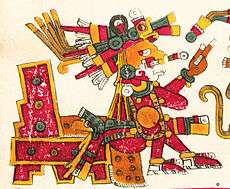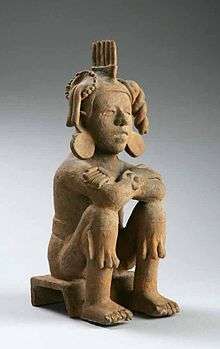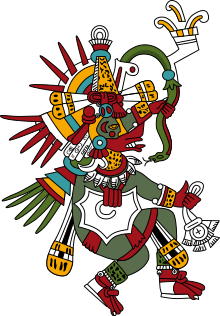Xōchipilli
Xōchipilli [ʃu˕ːt͡ʃiˈpiɬːi] is the god of art, games, dance, flowers, and song in Aztec mythology. His name contains the Nahuatl words xōchitl ("flower") and pilli (either "prince" or "child") and hence means "flower prince". As the patron of writing and painting, he was called Chicomexōchitl the "Seven-flower", but he could also be referred to as Macuilxōchitl "Five-flower".

Xōchipilli has also been interpreted as the patron of both homosexuals and male prostitutes, a role possibly resulting from his being absorbed from the Toltec civilization.[1] He, among other gods, is depicted wearing a talisman known as an oyohualli, which was a teardrop-shaped pendant crafted out of mother-of-pearl.[2]
Xochipilli statue
.jpg)
In the mid-19th century, a 16th-century Aztec statue of Xochipilli was unearthed on the side of the volcano Popocatépetl near Tlalmanalco. The statue is of a single figure seated upon a temple-like base. Both the statue and the base upon which it sits are covered in carvings of sacred and psychoactive organisms including mushrooms (Psilocybe aztecorum), tobacco (Nicotiana tabacum), Ololiúqui (Turbina corymbosa), sinicuichi (Heimia salicifolia), possibly cacahuaxochitl (Quararibea funebris), and one unidentified flower.
"The texts always use the flower in an entirely spiritual sense, and the aim of the religious colleges was to cause the flower of the body to bloom: This flower can be no other than the soul. The association of the flower with the sun is also evident. One of the hieroglyphs for the sun is a four-petalled flower, and the feasts of the ninth month, dedicated to Huitzilopochtliupo, were entirely given over to flower offerings."
- Paul Pettennude, Ph.D.
The figure himself sits on the base, head tilted up, eyes open, jaw tensed, with his mouth half open and his arms opened to the heavens. The statue is currently housed in the Aztec hall of the Museo Nacional de Antropología in Mexico City.
Entheogen connection

Lombards Museum
It has been suggested by Wasson,[3] Schultes, and Hofmann that the statue of Xochipilli represents a figure in the throes of entheogenic ecstasy. The position and expression of the body, in combination with the very clear representations of hallucinogenic plants which are known to have been used in sacred contexts by the Aztec support this interpretation.
Wasson says that in the statue's depiction Xochipilli "is absorbed by temicxoch, 'dream flowers', as the Nahua say describing the awesome experience that follows the ingestion of an entheogen. I can think of nothing like it in the long and rich history of European art: Xochipilli absorbed in temicxoch".[3]
See also
References
- Greenberg, David (1990). The Construction of Homosexuality. Chicago: University of Chicago Press. p. 165. ISBN 0-226-30628-3.
- Aguirre, Alejandra; Chávez, Ximena (27 March 2011). "Personified knives". mexicolore.co.uk. Retrieved 29 January 2017.
- Wasson, Robert Gordon (1980). The Wondrous Mushroom: Mycolatry in Mesoamerica. McGraw-Hill. p. 58. ISBN 978-0-07-068443-0.
External links
![]()
- J. Paul Getty Museum's in-depth interactive exploring the Museo Nacional de Antropología's 15th-century basalt figure of Xochipilli. Includes a detailed exploration of psychotropic plants depicted.
- Erowid's Xochipilli Vault
